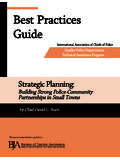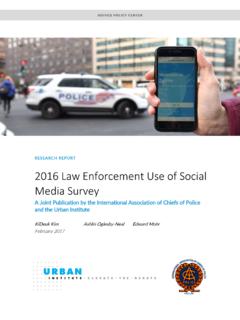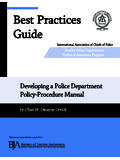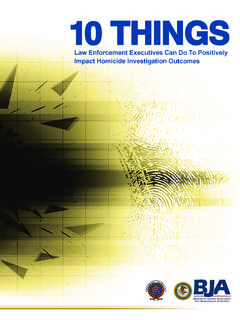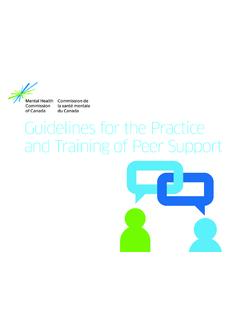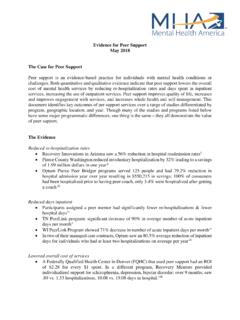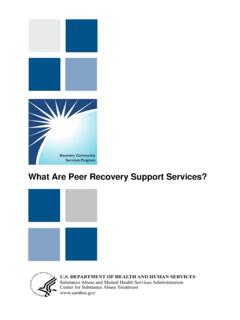Transcription of PEER SUPPORT AS A POWERFUL TOOL in Law Enforcement …
1 This resource was developed by the Bureau of Justice Assistance s National Consortium on Preventing Law Enforcement Suicide (the Consortium) and focuses on the role peer SUPPORT has in preventing officer suicide. The Consortium, led by the International Association of Chiefs of Police (IACP) in partnership with Education Development Center (EDC) and the National Action Alliance on Suicide Prevention (Action Alliance), brought together law Enforcement leaders alongside mental health and suicide prevention experts across the nation to address preventing suicide in law Enforcement .
2 Through the Consortium, five task force groups were formed to identify recommendations and considerations for the policing profession as it relates to suicide prevention efforts in an agency or department: messaging, data and research, organization and system change, peer SUPPORT , and family SUPPORT . peer SUPPORT is a key component in the Comprehensive Framework for Law Enforcement Suicide Prevention. This resource outlines how peer SUPPORT can best integrate suicide prevention strategies to SUPPORT fellow Power of PeersPeer SUPPORT serves as a POWERFUL resource for police in addressing stress management, mental health concerns, suicide prevention, and overall officer safety and wellness.
3 A 2018 survey of police officers found that 90% of respondents who had used peer SUPPORT reported that it was helpful to very helpful, 80% reported they would seek SUPPORT again if needed, and nearly 90% stated they would recommend peer SUPPORT to a Additionally, more than half of the officers who connected with peer SUPPORT indicated that these services helped them perform their job better or improved their personal life. Research in the general population has also demonstrated positive impacts to recipients of peer SUPPORT including improved hopefulness, greater satisfaction with life, greater quality of life, improved treatment engagement, better social functioning, and fewer problems peer supporters play a key role in many aspects of suicide prevention.
4 Peers can contribute by sharing positive recovery-oriented messages, decreasing barriers to seeking mental health services, normalizing help-seeking behaviors, strengthening healthy coping skills including resiliency and connectedness, and providing SUPPORT following a suicide loss or suicide attempt in an agency. peer SUPPORT AS A POWERFUL TOOL in Law Enforcement Suicide Prevention The biggest choosing of services for police officers is peer SUPPORT . 3 out 4 would rather go to peer SUPPORT than any other kind of services out there. Sherri Martin, National Wellness Director, National Fraternal Order of Police2 | NATIONAL OFFICER SAFETY INITIATIVESI ntegrating Suicide Prevention Best Practices in peer SUPPORT ProgrammingIndividuals at the top of the agency as well as those in supervisor roles should consider developing and incorporating peer SUPPORT units into their agency.
5 Leadership can demonstrate SUPPORT by designating a team leader, establishing standard operating procedures, assessing and allocating appropriate resources, trusting peer SUPPORT teams to follow standards for confidentiality, and advocating the use of peer SUPPORT to all staff in the agency. Agencies should invest resources in training, education, supervision, and ongoing professional development, when possible. Suicide prevention is more than responding to a crisis. A suicide death represents the end of what is, for many, a long struggle.
6 Mental health treatment, crisis response, and peer SUPPORT services exist on a continuum. Resources and services need to be organized to help identify those who need SUPPORT early in their struggle. peer SUPPORT services are essential and effective across a spectrum of mental health well-being and challenges. The type of peer SUPPORT interventions which should be used varies depending on level of need. Examples include: an officer that wants SUPPORT during a particularly challenging time in their life, a sergeant that is going through relationship or substance misuse issues, or a corrections officer that is showing signs of suicide risk.
7 peer SUPPORT providers often report that the extreme of crises can be prevented by addressing what appears to be lesser concerns and stressors on the mental health continuum. It is important for peers to be trained, receive consultation, and practice identifying and responding to suicide risk. peer supporters can use evidence-based and research-informed best practices in screening for, responding to, and following up on suicide risk. To determine the general peer SUPPORT model applied at a specific agency, it is important to review and research best practices, and learn from well-designed peer SUPPORT programs.
8 For instance, Cop2 Cop (C2C), a peer SUPPORT program for New Jersey officers and their families, uses the Reciprocal peer SUPPORT wellness model for their standard of care. This model includes four tasks: connecting, information gathering and risk assessment, care management/wellness planning, and resilience building. In addition, C2C peer supporters are certified in postvention SUPPORT after a suicide loss and as suicide prevention trainers to offer prevention and postvention Agencies should consider connecting with peer agencies, conducting additional research, and gathering feedback from officers to identify programming and training that would meet the unique needs of their When designing a peer SUPPORT team, leaders should consider setting appropriate selection criteria and processes ahead of providing training.
9 If possible, it is good to have a trained peer at each rank level. The most well-intentioned people, even with personal experience, must be vetted first and then, if selected, trained specifically in skills for both peer SUPPORT and suicide prevention. nSET appropriate expectations including screening out anyone seeking to be a part of a peer SUPPORT team for secondary gain, , only for a promotion, financial gain, or resume building. nINVOLVE at least one mental health professional in the selection process. nCONSIDER having fellow officers nominate one or two people that would make great peer supporters.
10 NLOOK for qualities of genuineness, altruism, maintaining appropriate boundaries, and skills in one s own self-care. nDEVELOP members who show characteristics that are good for peer SUPPORT and may need to build their confidence or need is a major piece that represents a barrier to treatment for officers. Tom Coghlan, Police Psychologist, Blue Line Psychological Services, PLLCNATIONAL OFFICER SAFETY INITIATIVES | 3 Training and Supervision Evidence-based content and professional training are at the core of effective peer SUPPORT .


